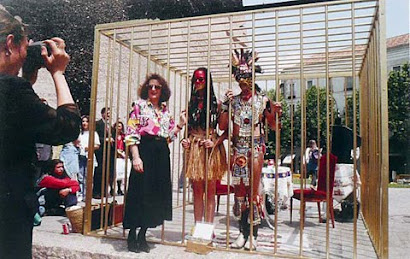“Are we researchers? Are we still artists? What should our relations be with galleries and museums?”

“…by founding the Group, we were deciding to leave aside the personal problems and ambitions of each one of us in favour of systematic research. We were reckoning on pooling a sum of concepts and research which would no longer owe anything to the whims of personal inspiration. At the same time we denounced the cult of personality and the speculation in which art and artists were the stake. We were keen to restore a certain conception of the public that had been devalued by obscurantist art criticism, which considered that art only addresses the elite.
To do this we planned to escape from the traditional gallery circuit, but to stay in touch with the public as closely as possible so as to change the existing situation.” (248)




We are particularly interested in the proliferation of works which permit of varied situations, whether they engender a strong visual excitement, or demand a move on the part of the spectator, or contain in themselves a principle of transformation, or whether they call for active participation from the spectator. To the extent that this proliferation allows the calling in question – even diffidently – of the normal relations between art and the spectator, we are its supporters. But this is only a first stage. The second might be, for example, to produce, no longer only the works, but ensembles which would play the part of social incitement, at the same time as liberating the spectator from the obsession with possession. These “multipliable” ensembles could take the form of centres of activation, games rooms, which would be set up and used according to the place and the character of the spectators. From then on, participation would become collective and temporary. The public could express its needs otherwise than through possession and individual enjoyment.
MANIFESTO (1967)
For this Group, the introduction of light is neither an advance nor an end in itself. Its use varies according to the situations presented: variations, progressions, reflections, transformations of structures, projections, revolving lights, neons, all have been used separately in isolated situations (luminous boxes, grids, or neons, for example) or integrated in mazes or halls.
This Group is not concerned to create a work having light as its subject, nor to produce a super stage-performance, but through provocation, through the modification of the conditions of environment, by visual aggression, by a direct appeal to active participation, by playing a game, or by creating an unexpected situation, to exert a direct influence on the public’s behaviour and to replace the work of art or the theatrical performance with a situation in evolution inviting the spectators participation.
This Group is not concerned to create a work having light as its subject, nor to produce a super stage-performance, but through provocation, through the modification of the conditions of environment, by visual aggression, by a direct appeal to active participation, by playing a game, or by creating an unexpected situation, to exert a direct influence on the public’s behaviour and to replace the work of art or the theatrical performance with a situation in evolution inviting the spectators participation.



Are you fun and adventure loving? Do you like new things, new ideas, new experiences? Do you love telling stories about last night's party?httpsgroupe-sanguine.fr
ReplyDelete